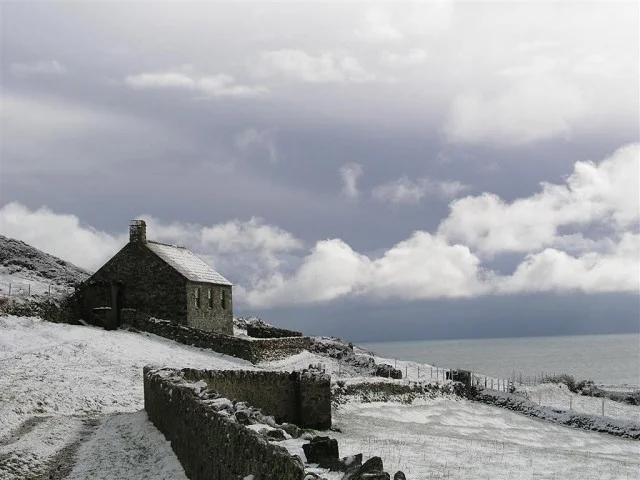Bardsey Island Caernarfon
Latest Rarities in Caernarfon
|
16/04/2024 16:27 |
Leach's Storm Petrel
Caernarfon Details |
|
13/04/2024 10:48 |
Corncrake
Caernarfon Details |
|
12/04/2024 09:19 |
Corncrake
Caernarfon Details |
|
11/04/2024 14:10 |
Corncrake
Caernarfon Details |
|
07/04/2024 15:53 |
Hoopoe
Caernarfon Details |
Latest Photo

- ©
- Steve Stansfield
Site Location Details
Site location details and google satellite image for Bardsey Island
Please click on the map icon below to load Bardsey Island in your preferred map
- Latitude\Longitude: 52.75963 , -4.78805
- Grid Reference:
- Easting:
- Northing:
Site Details
Ynys Enlli, the Welsh name for Bardsey, meaning 'the island in the currents', lies just three kilometres off the southern tip of the Llyn peninsula at the northern end of Cardigan Bay in North Wales. It is relatively small, being just 179 hectares (444 acres) in extent. It is separated from the mainland by the Bardsey Sound, a treacherous stretch of water with currents running up to nine knots when the spring tides are in full flood. Bardsey's geology forms part of the Precambrian sequence dating back some 580–610 million years and is similar in structure to that found in parts of Anglesey. It comprises mainly a matrix of slaty siltstone and mudstone with innumerable inclusions of sandstone, limestone and quartzite. There are a few igneous intrusions of olivine dolerite and numerous small-scale faults.
Surprisingly, for such a small island, Bardsey's natural history, and especially its birdlife, has been well described over the years: its wildlife by Roberts (1985) and Jones (1988), its flora by Bonner and Jones (2002) and its archaeology and cultural history by Jones and Arnold (1996). The presence of many rare and scarce species and habitats has led to the island's designation as a National Nature Reserve (NNR), a Site of Special Scientific Interest (SSSI), a Special Protection Area (SPA), an Area of Outstanding Natural Beauty, an Environmentally Sensitive Area (ESA); it is also part of the Pen Llyn Heritage Coast and it is covered by the Pen Llyn a'r Sarnau candidate Special Area of Conservation (cSAC). The observatory plays an important part in implementing the requirements of many of these designations, conducting much of the biological research and surveying required by Countryside Council for Wales (CCW) and contributing to the island's management policy. The warden and some members of the observatory committee are also members of the island's joint scientific committee, the advisory body to the Bardsey Island Trust.
Contact Details
Telephone: Observatory phone number 07855264151
Birding Sites in the Bardsey Island Area
Prominent Species at Bardsey Island
Subscriber Content
Bird News Pro and Bird News Ultimate subscribers get additional site details such as specialities and commonly seen species.
Additional Site Details
Directions
To reach the island, one must pass the immense hills and mountains of Snowdonia and Snowdon itself. From the north, the route winds past the city of Bangor, along the Menai Straits to Caernarfon and onto the Llyn following the pilgrims' trail of 1,500 years before. Continuing to the end of the Llyn, the small village of Aberdaron looks out across a long sandy beach to Ynysoedd Gwylan, the two small islands lying 1,500 metres offshore. These are home to 1,000 pairs of Puffin, 300 pairs of Guillemot and several hundred pairs of large gulls; they also hosted the only Welsh breeding records of Whimbrel in 1999 and 2000.From the south, the route runs past the castle at Criccieth before turning west to the port of Pwllheli, the last large town before entering rural Llyn. Continuing west along the peninsula takes you through several small villages until Uwchmynydd, the south-western tip of the Llyn, appears before you. From Mynydd Mawr, the hilltop of Uwchmynydd, the island can be viewed across the Bardsey Sound. From here it looks strangely like a baseball cap. The steep east face of Mynydd Enlli (The Mountain) rises from the sea with the west side falling gently down to the northern lowlands which reach out into the Irish Sea in the direction of Ireland.
From the car park at Cwrt Farm, just outside Aberdaron, the walk down the National Trust's wooded valley to the small cove at Porth Meudwy can give an exciting start to a birding trip. The valley can be almost as spectacular as Bardsey itself for passage migrants, and large numbers of common migrants have been recorded here as well as rarities such as Rüppell's Warbler and Lesser Grey Shrike. And to anticipate, for a moment, the visitor's return, he walks (or rides, if he is lucky), back up the same wooded valley and realises how the season has moved on in his absence, particularly in spring, and the longer he has tarried on the island, the greater his surprise.
The regular boat to the island usually sails on Saturdays, but occasionally on weekdays by prior arrangement, from the sheltered commercial shellfishing cove of Porth Meudwy, one and a half kilometres south-west from Aberdaron village. As the name Ynys Enlli (the aforesaid ‘island in the currents') suggests, the boat journey out can be an adventure in itself. Adverse weather conditions and the treacherous currents mean the journey isn't always possible and visitors are sometimes delayed coming both on and off the island. In the 21st century, when lives are dictated by the smallest detail, it can be one of the gifts of Bardsey that, for once, you are not in control, but are entirely dependent on the wind and tides. In the 1960s, when a much smaller boat was in use, powered by just a small outboard motor, there were tales of visitors, marooned on the island for several weeks due to the strong winds and rough seas, being reduced to eating gulls' egg omelettes with wild mushrooms after running out of food stocks. However, these stories were perhaps always the island equivalent of fishermen's tales. Now, with the presence of the observatory's grocery shop, no recent visitors have gone hungry when delayed. The present boat is also much larger, is better equipped and makes the journey more regularly. A particularly good year was 2005, when during the visitor season, crossings were not possible on only two Saturdays, and the boat arrived on the Sunday on both of those weekends.
As the 12-passanger motorboat rounds the headland of Pen y Cil, the first views of the island are offered to the visitor; a large hump rising 167 metres sharply from the sea, looking rather inhospitable at first sight. All that can be seen are the rocky cliffs, bare scree and a large expanse of the sparsely grassed areas of the east side of Mynydd Enlli. Most of the island is hidden from view as the boat makes the 20 minute crossing.
As the boat approaches the island in the summer, the number of seabirds flying to and from the cliffs becomes apparent and the first view of the horizontally striped, red and white lighthouse is obtained. The boat then docks in Cafn Enlli, a small and sheltered cove with a concrete slipway and gabion jetty.
Access
Access by boat from Aberdaron. A day trip will allow around 3.5 hours on the island. Telephone Colin Evans on 07971 769895 for day trip details.Parking
At Cwr Farm Aberdaron, post code LL53 8DAFacilities
Bird Observatory, gift shops, cafe (11am to 1 pm)Key Areas / Routes
Once off the boat and at the top of the Cafn by the old boathouse, with its associated small shellfishing vessels and tackle, the island can be seen in its full glory. Aligned roughly on a north-south axis, it is almost three kilometres at its longest and one kilometre at its widest, and the irregular shape can be divided into two main areas. The South End is low lying, a roughly oval area of land, whilst the North End is a roughly rectangular area, consisting of lowland fields on the west side and the Mountain on the east side. These areas are joined by the Narrows, a narrow isthmus which, at its narrowest, is less than 30 metres wide.Looking north and east from here, the gorse and bracken-covered west face of the Mountain can be seen. Due north are the fertile lowlands and grazing pasture, and to the south is the plateau of the South End.
The coastline, about 10 kilometres in length, comprises a mixture of high sea cliffs on the east, home to a thriving seabird colony, and lower cliffs and a more gentle sloping rocky coast on the north and west side. The Narrows has, on its northern shore, the only sandy beach on the island, at Porth Solfach. It is here that many migrant waders, such as Dunlin, Sanderling, Turnstone and Ringed Plover, can be seen in spring and autumn, from the small wooden hide situated on top of the beach, below a grassy bank. To the south of the Narrows is the wide bay of Henllwyn, the only real haven for visiting yachts and charter boats. The seaweed-covered rocks are home to up to 400 Grey Seals during the summer months, with numbers falling to about 150 during the winter. It is here that the larger waders are most frequently seen, with Oystercatchers and Curlew numbering into the hundreds during autumn and winter. Much of the southern coastline is bounded by fairly steep cliffs, rising to 30 metres above sea level, which are unsuitable for nesting seabirds, and the very few ledges here are utilised by Ravens and Carrion Crows.
Towards the centre of the island, the only significant stream drains through the lowlands before flowing into the sea, just north of Solfach. It is along this stream that three of the island's four withy beds (areas of low-lying willows), and the larger of the two established reed beds, are found. The withies were once coppiced for the production of lobster pots, but are now managed by the observatory for wildlife and are important ringing sites and a haven for passage migrants. At the top end of the stream, a small triangular reed bed borders one of the few permanent water bodies, Pwll Cain. This small pond was excavated in the early 1980s, though it has become much reduced in size and rather overgrown in recent years but still produces the occasional good find. There are several smaller ponds, wells and springs scattered throughout the island and many additional small streams and ponds form during the winter months.
The western side of the Mountain is now heavily covered in Gorse and heather. Extensive areas of Bracken are also found amongst some rather impressive lichen-covered rocky outcrops.
At the north end of the island is the Nant plantation, measuring 100 metres by 20 metres and often 'crawling' with migrant warblers.
Site Photographs
If you would like to suggest a photo for this site, please email a copy to contact@birdguides.com along with the website address for this page. A member of our team will review your photograph for suitability and will credit the image to you (unless you request otherwise).
Best regards,
The BirdGuides Team.
Most Recent Gallery Photos
View all recent gallery photos
Useful Links
- http://www.bbfo.org.uk/
-
http://www.bbfo.org.uk/
Visit Website (opens in new window) - http://www.bardsey.org
-
http://www.bardsey.org
Visit Website (opens in new window)
British & Irish Records Archive Bardsey Island
All Records (Accepted, Rejected, Pending). To filter/search please enter a phrase. E.g. To filter Rejected records, type Rejected into the Search box, all columns can be filtered.















